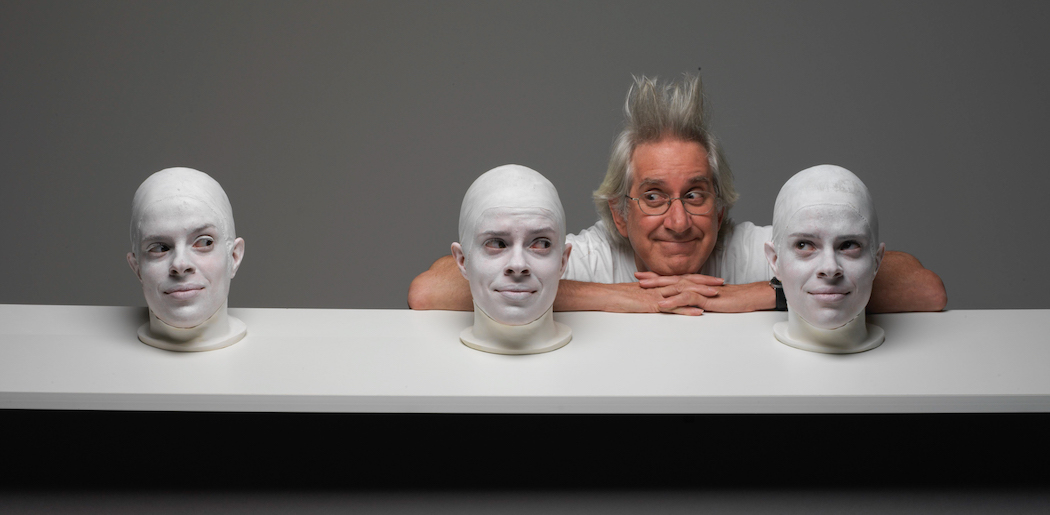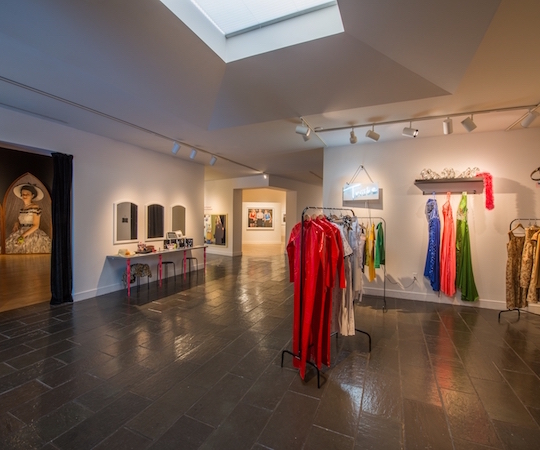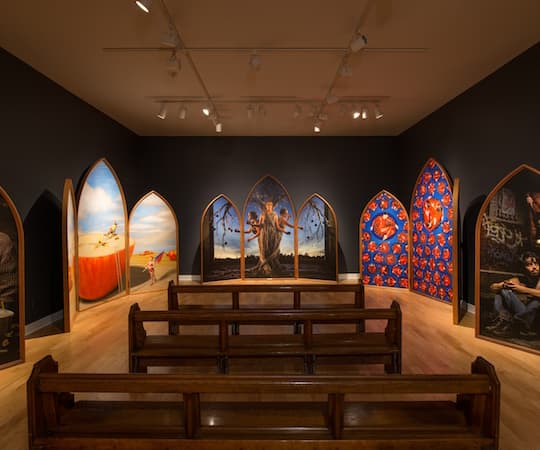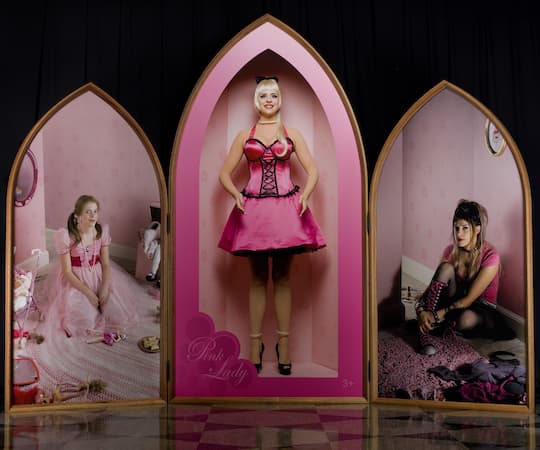Advertisement
Fitchburg Art Museum's 'TRIIIBE' Questions Identity In The Modern Age

FITCHBURG, Mass. — Up a flight of stairs at the Fitchburg Art Museum, visitors may think they've wandered in through the backstage door to a theatrical performance. Racks of sequined gowns, red vinyl jumpsuits, dresses, wigs, shoes and a vanity table are arranged across the mezzanine as a faux dressing room, as if actors are about to don costumes and apply their makeup.
It's a brilliant entry point for "TRIIIBE: same difference," an engaging and eye opening new exhibit (through June 5) that showcases the work of TRIIIBE, an artistic collaboration between performance artists Alicia, Kelly and Sara Casilio, who are identical triplets, and photographer Cary Wolinsky. Films of the group's work by Yari Wolinsky, Cary's son, capture some of the Casilio's original performances and take viewers behind-the-scenes into the process of creating the meticulously staged photographs — including the contributions of designers, their printer and a master woodworker.

The 36-year-old Casilios, graduates of Massachusetts College of Art and Design, create and stage performance art that riffs on their sameness and differences as triplets. Dressed in elaborate costumes and acting out roles, the sisters embody personas that provoke questions about identity, gender, race, class and religion. Cary Wolinsky, decades their senior, is an award-winning photographer who spent an acclaimed career traveling the world for National Geographic.
A chance meeting at a party in 2004 sparked their curiosity about how they might work together. Now, the unlikely collective brings their creative visions together and elevates their art forms into wondrous photographs. Over the years, TRIIIBE have taken their original performances to a wide array of venues, from date-night pickup bars to the 2007 protest against the Iraq War in Washington, D.C., to Wall Street and the Institute of Contemporary Art. Site-specific shows have been mounted at Gallery Kayafas and Boston University's Gallery 808, as well as Dodge Gallery in New York.
The Fitchburg exhibit, the first retrospective at a museum, features 13 single prints and seven large-scale triptychs. In image after image, the Casilio sisters are transformed into trios of other characters that draw from a variety of sources — biblical themes, art history, fashion, contemporary culture and current events. The photographs range from playful and whimsical to satirical; some are emotionally jarring.
“They are very sophisticated image makers. . . borrowing techniques from visual language as disparate as advertising, cinema, religion, history of art and political propaganda,” says Nick Capasso, the museum's director. Capasso first met the Casilio sisters some 15 years ago, when he was invited to critique a MassArt class they were taking. “I was hooked from day one,” he explained in a recent phone conversation, recalling that as he followed their work, he hoped to one day mount a large-scale exhibit.
Among the photographs in one gallery is the delightfully satirical “Miss,” with Alicia, Kelly and Sara posing in sequined gowns and crowned in a beauty pageant. The ribbons draped across their chests offer clever word play, “Miss Represent,” “Miss Lead,” and “Miss Apprehension,” poking fun at the idea of judging superficial beauty.

“Equal Opportunity,” takes on gender, reproduction and motherhood. The sisters, appearing pregnant, are costumed in different get-ups. They stare out almost expressionless, with their hands on their rounded bellies. The version hanging in the show is a lenticular print, a process that combines two separate photographs. As viewers move in closer and from side to side, the images shift, revealing the trio as pregnant males.
“Themes of identity are at the core of every TRIIIBE image, allowing people to grapple with their own definitions and how fluid that can be,” says Mary Tinti, the museum's curator. Capasso and Tinti also believe TRIIIBE's humor to be key to its accessibility — an accessibility that gives the museum the opportunity to achieve its goal of expanding the range of contemporary art to Fitchburg and surrounding communities. “It's beautifully disarming and allows you to be comfortable with some very uncomfortable topics,” Tinti explains.
Growing up as triplets presented it challenges, with periods when each sister was searching for her own identity. “Our identities were always an issue in our lives,” admitted Sara over the phone. Just walking down the street attracted attention, Alicia added. They decided to embrace it. “Why not redirect it to be more thoughtful,” Alicia said of their decision to create performance-based, artistic experiences that had a story and message to share. Over the years, Wolinsky has come to appreciate how well the sisters work together.“They have such a feel for each others' sensitivities,” he observed in a separate conversation.

“Right to Life,” is a disturbing end-of-life scene that confronts capital punishment and reproductive rights. One sister, pregnant, is strapped into an electric chair, staring out directly to viewers, looking both desperate and as if she is ready to bolt. On either side stands a male prison guard and a priest holding a Bible, staring out blankly in the distance. Despite the stark differences in their circumstances, the sameness of the triplets’ faces strikes a chord of shared humanity.
The Fitchburg show also debuts a new work, a photograph of a weaving that embraces motherhood. Kelly spun and dyed the wool during her pregnancy. From a distance, the weaving is an array of colors. Walk up close and viewers notice tiny protrusions, tips of noses, a mouth, and eyes emerging through the tapestry.
The second gallery holds TRIIBE's ambitious tour-de-force, seven of the large-scale triptychs from “In Search of Eden,” originally created and mounted for a show at Gallery 808. Each image is based on a different type of apple, a reference to the biblical story of Adam and Eve in the Garden of Eden. The entire room evokes a sense of religiosity, including a set of church pews where visitors can sit and view the work as well as read guides prepared by the museum.

“Pink Lady” features the sisters in three panels that project different stages and ideals of beauty — Sara as an innocent child playing dress-up as a kind of frilly doll; Alicia, punk-clad, strikes the oppositional chords of a teen's defiance and insecurity; Kelly takes on Barbie — the quintessential idealized, stiff plastic-like image of what a girl and woman is supposed to look like.
"McIntosh" is a breathtaking sight, evoking a medieval altarpiece with the sisters looming larger than life in the center panel. Wrapped in layers of brown roots, they are entwined in the biblical Tree of Knowledge, illuminated against a naturalistic landscape of a darker blue sky. In their bare arms, each holds or reaches out to the branches for the forbidden red apples. Printed on canvas, the photographs take on an almost surrealist painterly quality.
The museum will host an educators' workshop on Thursday, March 10, several curator's tours and a gallery talk by Alicia, Kelly and Sara Casilio and Cary Wolinsky on Sunday, April 24. For more information, visit the museum's website.